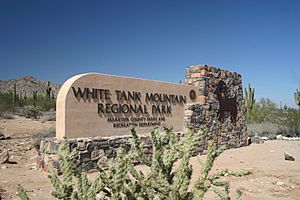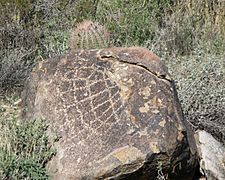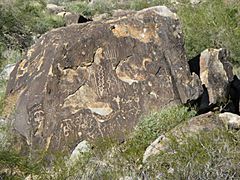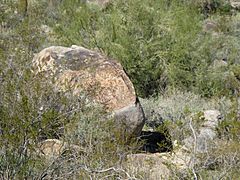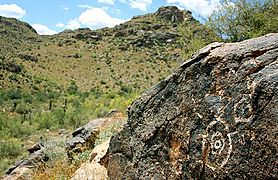White Tank Mountain Regional Park facts for kids
Quick facts for kids White Tank Mountain Regional Park |
|
|---|---|
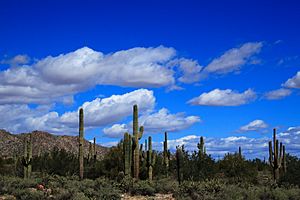
Desert vegetation in the park.
|
|
| Location | Maricopa County, Arizona, United States |
| Nearest city | Waddell, Arizona |
| Area | 29,271 acres |
The White Tank Mountain Regional Park is a huge park in Maricopa County, Arizona. It covers about 29,271 acres (or 45 square miles) of desert and mountains. This makes it the biggest park in the county! Most of the White Tank Mountains are right inside the park. It's a great place to explore nature and learn about the desert.
Contents
Fun Things to Do in the Park
The park has many cool outdoor activities for everyone. You can find shaded picnic spots called ramadas, picnic areas, and campgrounds. These are perfect for family gatherings or just relaxing. Some camping spots are set up for RVs. They have picnic tables, barbecue grills, and restrooms with showers.
Hiking and Biking Trails
The park is famous for its many hiking trails. There are almost 26 miles of trails winding through the park's landscape. Some trails are easy walks, while others are a bit more challenging.
The most popular trail is the Waterfall Trail. It's about 0.9 miles long. This trail leads to a narrow canyon with a seasonal waterfall. It's a beautiful sight, especially after it rains! You can also ride bikes and horses on many of the trails. There's even a special 10-mile track for competitive biking and racing.
Stargazing and Events
The desert usually has clear skies. Plus, the park is far from city lights, making it a great place for stargazing. You can see so many stars! The park often hosts special stargazing events throughout the year.
Many other fun events happen regularly too. These include guided nature walks and health walks. There are also special events just for kids and families.
White Tank Library and Nature Center
The White Tank Library and Nature Center opened in 2010. It's located right at the park's entrance. This large building is designed to be very eco-friendly. The library has a big window with amazing views of the park.
The nature center is a cool place to visit. It has live native reptiles that live in the desert. You can also find an information center and a gift shop. The center offers nature education programs for kids, families, and adults. It's a great way to learn about the desert environment.
Nature and History of the Park
The park is a huge area of desert and mountains. It also acts as a natural preserve. This means a lot of the park is wild and undeveloped. You can only drive motorized vehicles on existing roads. Hiking is also usually limited to marked trails to protect the environment. Some hunting is allowed, but with strict rules.
Desert Animals and Plants
Many local animals live in the park. Visitors often spot mule deer, coyotes, and javelinas. You might also see small rodents. Sometimes, if you're lucky, you might even spot a mountain lion!
Many different birds also call the park home. These include the famous roadrunner and the cactus wren. The cactus wren is the official state bird of Arizona! Since it's a desert, the park also has many types of reptiles. The park offers guided hikes where you can learn about and see the native flora (plants) and fauna (animals).
Flash Floods and Waterfalls
The area is usually dry. However, it can have sudden and strong flash flooding in the narrow canyons. This often happens during thunderstorms in late summer. While floods can be dangerous, they also create temporary waterfalls. These waterfalls in the rugged mountains are a special attraction for visitors during certain times of the year.
Ancient History: Hohokam People
The mountains are also home to many archaeological sites. Eleven sites have been found inside the park. Seven of these were villages where the Hohokam people lived between 500 and 1100 CE.
The Black Rock Trail leads to what's left of one of these villages. However, the remains are not always easy to see. What's easier to spot are the many petroglyphs (rock carvings) found throughout the park. Most of these were made by the Hohokam people. Some might even be nearly 10,000 years old, made by even older groups of people! The park encourages visitors to take pictures of petroglyphs. But remember, it's very important not to touch or disturb them. This helps protect these ancient artworks for everyone to enjoy.
- Petroglyphs in the White Tank Mountain Regional Park
Protecting the Park
The White Tank Regional Park is on the edge of the Phoenix metropolitan area. It's next to fast-growing cities like Buckeye and Surprise. These cities are growing quickly, and new homes are being built close to the park.
Some environmentalists and park officials are worried about this growth. They are concerned that human activity might harm the park's ecology (the balance of nature).
The city of Surprise is right next to the park's north and east sides. To help protect the park, city planners have made preserving the White Tank Mountains a top priority. Their plan includes a "greenbelt" buffer zone. This zone is meant to separate new homes from the park. However, some people worry that the park might still become like an "ecological island." This means it could be cut off from other natural areas, which might make it harder for animals and plants to thrive.


